Quantification and Driving Factors of Cultivated Land Fragmentation in Rapidly Urbanizing Area: A Case Study in Guangdong Province
Abstract
:1. Introduction
2. Materials and Methods
2.1. Study Area
2.2. Data Sources
2.3. Research Methods
2.3.1. Quantitative Indicators of Cultivated Land Fragmentation
2.3.2. CRITIC Empowerment
2.3.3. Identification of Hot Spots and Cold Spots
2.3.4. Driver Analysis of Cultivated Land Fragmentation
3. Results
3.1. Land Cover Changes in Guangdong Province from 2000 to 2020
3.2. Temporal Characteristics of Cultivated Land Area and Cultivated Land Fragmentation in Guangdong Province
3.3. Spatial Pattern and Characteristics of Cultivated Land Fragmentation in Guangdong Province
3.4. Regression Results for the Driving Factors of Cultivated Land Fragmentation
3.5. Driving Factors of Cultivated Land Fragmentation
4. Discussion
4.1. The Spatio-Temporal Characteristics of CLF in Guangdong Province
4.2. The Characteristics of the Driving Factors of CLF in Guangdong Province
4.3. Implications for Rural Sustainable Development
4.4. Limitations and Future Challenges
5. Conclusions
Author Contributions
Funding
Data Availability Statement
Conflicts of Interest
References
- Rosenzweig, C.; Parry, M.L. Potential impact of climate change on world food supply. Nature 1994, 367, 133–138. [Google Scholar] [CrossRef]
- Tilman, D.; Balzer, C.; Hill, J.; Befort, B.L. From the cover: Global food demand and the sustainable intensification of agriculture. Proc. Natl. Acad. Sci. USA 2011, 108, 20260. [Google Scholar] [CrossRef] [PubMed]
- Chen, X.P.; Cui, Z.L.; Fan, M.S.; Vitousek, P.; Zhao, M.; Ma, W.Q.; Wang, Z.L.; Zhang, W.J.; Yan, X.Y.; Yang, J.C.; et al. Producing more grain with lower environmental costs. Nature 2014, 514, 486–489. [Google Scholar] [CrossRef] [PubMed]
- Chen, Y.M.; Yao, M.R.; Zhao, Q.Q.; Chen, Z.J.; Jiang, P.H.; Li, M.C.; Chen, D. Delineation of a basic farmland protection zone based on spatial connectivity and comprehensive quality evaluation: A case study of Changsha City, China. Land Use Policy 2021, 101, 105145. [Google Scholar] [CrossRef]
- Costanza, R.; d’Arge, R.; DeGroot, R.; Farber, S.; Grasso, M.; Hannon, B.; Limburg, K.; Naeem, S.; Oneill, R.V.; Paruelo, J.; et al. The value of the world’s ecosystem services and natural capital. Nature 1997, 387, 253–260. [Google Scholar] [CrossRef]
- Dogliotti, S.; García, M.C.; Peluffo, S.; Dieste, J.P.; Pedemonte, A.J.; Bacigalupe, G.F.; Scarlato, M.; Alliaume, F.; Alvarez, J.; Chiappe, M.; et al. Co-Innovation of Family Farm Systems: A Systems Approach to Sustainable Agriculture. Agric. Syst. 2014, 126, 76–86. [Google Scholar] [CrossRef]
- Piñeiro, V.; Arias, J.; Dürr, J.; Elverdin, P.; Ibáñez, A.M.; Kinengyere, A.; Opazo, C.M.; Owoo, N.; Page, J.R.; Prager, S.D.; et al. A Scoping Review on Incentives for Adoption of Sustainable Agricultural Practices and Their Outcomes. Nat. Sustain. 2020, 3, 809–820. [Google Scholar] [CrossRef]
- Smit, B.; Cai, Y.L. Climate change and agriculture in China. Glob. Environ. Chang. 1996, 6, 205–214. [Google Scholar] [CrossRef]
- Zhou, Y.; Li, X.H.; Liu, Y.S. Cultivated land protection and rational use in China. Land Use Policy 2021, 106, 105454. [Google Scholar] [CrossRef]
- Wang, L.Y.; Anna, H.; Zhang, L.Y.; Xiao, Y.; Wang, Y.Q.; Xiao, Y.; Liu, J.G.; Ouyang, Z.Y. Spatial and Temporal Changes of Arable Land Driven by Urbanization and Ecological Restoration in China. Chin. Geogr. Sci. 2019, 29, 809–819. [Google Scholar] [CrossRef]
- Liu, Y.S.; Qiao, L.Y. Innovating system and policy of arable land conservation under the new-type urbanization in China. Econ. Geogr. 2014, 34, 1–6. [Google Scholar]
- Kong, X.B. Analysis of current issues and countermeasures in cultivated land protection. China Land 2020, 419, 4–7. [Google Scholar]
- Zhou, Y.R.; Chen, T.Q.; Feng, Z.; Wu, K.N. Identifying the contradiction between the cultivated land fragmentation and the construction land expansion from the perspective of urban-rural differences. Ecol. Inform. 2022, 71, 101826. [Google Scholar] [CrossRef]
- Looga, J.; Jürgenson, E.; Sikk, K.; Matveev, E.; Maasikamäe, S. Land Fragmentation and Other Determinants of Agricultural Farm Productivity: The Case of Estonia. Land Use Policy 2018, 79, 285–292. [Google Scholar] [CrossRef]
- Tu, Y.; Chen, B.; Yu, L.; Xin, Q.C.; Gong, P.; Xu, B. How does urban expansion interact with cropland loss? A comparison of 14 Chinese cities from 1980 to 2015. Landsc. Ecol. 2021, 36, 243–263. [Google Scholar] [CrossRef]
- Qiu, L.F.; Zhu, J.X.; Pan, Y.; Wu, S.H.; Dang, Y.X.; Xu, B.G.; Yang, H. The positive impacts of landscape fragmentation on the diversification of agricultural production in Zhejiang Province, China. J. Clean. Prod. 2020, 251, 119722. [Google Scholar] [CrossRef]
- Ntihinyurwa, P.D.; De Vries, W.T. Farmland Fragmentation Concourse: Analysis of Scenarios and Research Gaps. Land Use Policy 2021, 100, 104936. [Google Scholar] [CrossRef]
- Cao, Y.; Zou, J.; Fang, X.Q.; Wang, J.Y.; Cao, Y.; Li, G.Y. Effect of Land Tenure Fragmentation on the Decision-Making and Scale of Agricultural Land Transfer in China. Land Use Policy 2020, 99, 104996. [Google Scholar] [CrossRef]
- Abrantes, P.; Fontes, I.; Gomes, E.; Rocha, J. Compliance of Land Cover Changes with Municipal Land Use Planning: Evidence from the Lisbon Metropolitan Region (1990–2007). Land Use Policy 2016, 51, 120–134. [Google Scholar] [CrossRef]
- Farley, K.A.; Ojeda-Revah, L.; Atkinson, E.E.; Eaton-González, B.R. Changes in land use, land tenure, and landscape fragmentation in the Tijuana River Watershed following reform of the ejido sector. Land Use Policy 2012, 29, 187–197. [Google Scholar] [CrossRef]
- Deng, J.S.; Qiu, L.F.; Wang, K.; Yang, H.; Shi, Y.Y. An integrated analysis of urbanization-triggered cropland loss trajectory and implications for sustainable land management. Cities 2011, 28, 127–137. [Google Scholar] [CrossRef]
- Han, P.; Xiang, J.W.; Zhao, Q.L. Spatial differentiation and scenario simulation of cultivated land in mountainous areas of Western Hubei, China: A PLUS model. Environ. Sci. Pollut. Res. 2023, 30, 52804–52817. [Google Scholar] [CrossRef] [PubMed]
- Xu, M.Y.; Niu, L.; Wang, X.B.; Zhang, Z.F. Evolution of Farmland Landscape Fragmentation and Its Driving Factors in the Beijing-Tianjin-Hebei Region. J. Clean. Prod. 2023, 418, 138031. [Google Scholar] [CrossRef]
- Qi, X.X.; Dang, H.P. Addressing the Dual Challenges of Food Security and Environmental Sustainability during Rural Livelihood Transitions in China. Land Use Policy 2018, 77, 199–208. [Google Scholar] [CrossRef]
- Gomes, E.; Banos, A.; Abrantes, P.; Rocha, J.; Kristensen, S.B.P.; Busck, A. Agricultural land fragmentation analysis in a peri-urban context: From the past into the future. Ecol. Indic. 2019, 97, 380–388. [Google Scholar] [CrossRef]
- Yu, P.H.; Fennell, S.; Chen, Y.Y.; Liu, H.; Xu, L.; Pan, J.W.; Bai, S.Y.; Gu, S.X. Positive Impacts of Farmland Fragmentation on Agricultural Production Efficiency in Qilu Lake Watershed: Implications for Appropriate Scale Management. Land Use Policy 2022, 117, 106108. [Google Scholar] [CrossRef]
- Tran, T.Q.; Vu, H.V. Land Fragmentation and Household Income: First Evidence from Rural Vietnam. Land Use Policy 2019, 89, 104247. [Google Scholar] [CrossRef]
- Ciaian, P.; Guri, F.; Rajcaniova, M.; Drabik, D.; Paloma, S.G.Y. Land Fragmentation and Production Diversification: A Case Study from Rural Albania. Land Use Policy 2018, 76, 589–599. [Google Scholar] [CrossRef]
- Xu, M.Y.; Zhang, Z.F. Spatial Differentiation Characteristics and Driving Mechanism of Rural-Industrial Land Transition: A Case Study of Beijing-Tianjin-Hebei Region, China. Land Use Policy 2021, 102, 105239. [Google Scholar] [CrossRef]
- Hartvigsen, M.B. Land Reform and Land Consolidation in Central and Eastern Europe after 1989: Experiences and Perspectives. Ph.D. Thesis, Aalborg Universitetsforlag, Aalborg, Denmark, 2015. [Google Scholar] [CrossRef]
- Qian, F.K.; Pang, R.R.; Yu, Y.; Xu, H.; Han, C.L. Spatial correlation characteristics and mechanism of cultivated land landscape pattern and cultivated land quality in different geomorphic areas of Liaoning Province. Chin. J. Eco-Agric. 2023, 31, 113–124. [Google Scholar]
- Ye, J.Z. Land Transfer and the Pursuit of Agricultural Modernization in China. J. Agrar. Chang. 2015, 15, 314–337. [Google Scholar] [CrossRef]
- Yang, J.; Huang, X. The 30 m annual land cover dataset and its dynamics in China from 1990 to 2019. Earth Syst. Sci. Data 2021, 13, 3907–3925. [Google Scholar] [CrossRef]
- Center for International Earth Science Information Network (CIESIN)/Columbia University, and Information Technology Outreach Services (ITOS)/University of Georgia. Global Roads Open Access Data Set, Version 1 (gROADSv1); NASA Socioeconomic Data and Applications Center (SEDAC): Palisades, NY, USA, 2013.
- Tan, S.H.; Qu, F.T.; Nike, H. Analysis of the causes of land fragmentation and its influencing factors. China Rural Surv. 2003, 24–30+74. [Google Scholar]
- Hou, A.F. A study of the impact of cultivated land fragmentation on agricultural mechanization. J. Chin. Agric. Mech. 2009, 68–72. [Google Scholar] [CrossRef]
- Tian, C.H.; Chen, H.H.; Jia, S.H. The impact of agricultural land markets on cropland fragmentation—Theory and experience from Jiangsu, Zhejiang and Shandong. China Econ. Q. 2005, 769–784. [Google Scholar]
- Qing, J.Y.; Xue, L.Y. Analysis of landscape fragmentation of arable land in the Wangcun River basin. J. Shanxi Norm. Univ. (Nat. Sci. Ed.) 2017, 31, 119–122. [Google Scholar] [CrossRef]
- Diakoulaki, D.; Mavrotas, G.; Papayannakis, L. Determining objective weights in multiple criteria problems: The critic method. Comput. Oper. Res. 1995, 22, 763–770. [Google Scholar] [CrossRef]
- Getis, A.; Ord, J.K. The Analysis of Spatial Association by Use of Distance Statistics. Geogr. Anal. 1992, 24, 189–206. [Google Scholar] [CrossRef]
- Han, Z.; Song, W. Abandoned Cropland: Patterns and Determinants within the Guangxi Karst Mountainous Area, China. Appl. Geogr. 2020, 122, 102245. [Google Scholar] [CrossRef]
- Guo, A.; Yue, W.; Yang, J.; Xue, B.; Xiao, W.; Li, M.; He, T.; Zhang, M.; Jin, X.; Zhou, Q. Cropland Abandonment in China: Patterns, Drivers, and Implications for Food Security. J. Clean. Prod. 2023, 418, 138154. [Google Scholar] [CrossRef]
- Deng, X.; Huang, J.; Rozelle, S.; Zhang, J.; Li, Z. Impact of Urbanization on Cultivated Land Changes in China. Land Use Policy 2015, 45, 1–7. [Google Scholar] [CrossRef]
- Fotheringham, A.S.; Brunsdon, C.; Charlton, M. Geographically Weighted Regression: The Analysis of Spatially Varying Relationships; John Wiley and Sons, Ltd.: West Sussex, UK, 2003. [Google Scholar]
- Fotheringham, A.S.; Yang, W.B.; Kang, W. Multiscale Geographically Weighted Regression (MGWR). Ann. Am. Assoc. Geogr. 2017, 107, 1247–1265. [Google Scholar] [CrossRef]
- Girardet, X.; Foltête, J.C.; Clauzel, C. Designing a Graph-Based Approach to Landscape Ecological Assessment of Linear Infrastructures. Environ. Impact Assess. Rev. 2013, 42, 10–17. [Google Scholar] [CrossRef]
- Liu, L.; Liu, Z.J.; Gong, J.Z.; Wang, L.; Hu, Y.M. Quantifying the amount, heterogeneity, and pattern of farmland: Implications for China’s requisition-compensation balance of farmland policy. Land Use Policy 2019, 81, 256–266. [Google Scholar] [CrossRef]
- Chen, X.Y.; Zhan, Q.M.; Fan, Y.L. Classification and Evaluation Methods for Optimization of Land Use Efficiency at Village Level. Land 2023, 12, 710. [Google Scholar] [CrossRef]
- Han, B.; Jin, X.B.; Sun, R.; Xiang, X.M.; Liu, J.; Cao, S.; Zhou, Y.K. Optimized allocation of cultivated land in land consolidation project area based on multi-objective linear programming. J. Nat. Resour. 2019, 34, 718–731. [Google Scholar] [CrossRef]
- Wu, S.M.; Ye, Y.M.; Zhang, C.Z.; Wen, G.H. Impacts of different modes of rural land consolidation on cultivated land fragmentation and its regional differences: Empirical evidence from Jianghan Plain and Wuling Mountain area in Hubei Province. China Land Sci. 2021, 35, 98–106. [Google Scholar]
- Su, M.Y.; Fang, X.Q.; Sun, K.Y.; Bao, J.H.; Cao, Y. Construction and optimization of an ecological network in the comprehensive land consolidation project of a small rural town in southeast China. Sustainability 2023, 15, 5984. [Google Scholar] [CrossRef]
- Song, W.; Ye, C. Impact of the Cultivated-Land-Management Scale on Fertilizer Reduction—Empirical Evidence from the Countryside of China. Land 2022, 11, 1184. [Google Scholar] [CrossRef]
- Wang, D.; Yang, H.; Hu, Y.; Zhu, A.X.; Mao, X. Analyzing Spatio-Temporal Characteristics of Cultivated Land Fragmentation and Their Influencing Factors in a Rapidly Developing Region: A Case Study in Guangdong Province, China. Land 2022, 11, 1750. [Google Scholar] [CrossRef]
- Zhang, Z.F.; Yang, H.; Gu, X.K. Effects of land consolidation in plains and hills on plots use. Trans. Chin. Soc. Agric. Eng. 2013, 29, 1–8. [Google Scholar]
- Yun, W.Q.; Zhu, D.L.; Tang, H.Z. Reshaping and innovation of China land consolidation strategy. Trans. Chin. Soc. Agric. Eng. 2016, 32, 1–8. [Google Scholar]
- Li, H.; Yin, M.H.; Ma, Y.L.; Kang, Y.X.; Jia, Q.; Qi, G.P.; Wang, J.H. Effects of planting scale and fragmentation on the behavior of smallholders’ farmland quality protection: Taking the application of pesticide and fertilizer in vegetable cultivation as an example. China Land Sci. 2022, 36, 74–84. [Google Scholar]
- Zhang, M.Y.; Chen, Q.X.; Zhang, K.W. Influence of the variation in rural population on farmland preservation in the rapid urbanization area of China. J. Geogr. Sci. 2021, 31, 1365–1380. [Google Scholar] [CrossRef]
- Sun, X.; Bi, R.T.; Ding, Y.; Ning, F. Effects of cultivated land fragmentation on farmers’ livelihood strategies in impoverished mountainous areas: A case study of 87 villages in Qingzhang River Basin of Zouquan County. China Land Sci. 2018, 32, 40–47. [Google Scholar]
- Qiu, T.W.; Choy, S.T.B.; Li, Y.F.; Luo, B.L.; Li, J. Farmers’ Exit from Land Operation in Rural China: Does the Price of Agricultural Mechanization Services Matter? China World Econ. 2021, 29, 123–150. [Google Scholar] [CrossRef]
- Su, M.Y.; Wu, J.L. Impact of comprehensive land consolidation rehabilitation on ecosystem services: A case study of the Shazai Island, Jiangmen, Guangdong Province. Trop. Geogr. 2021, 41, 159–166. [Google Scholar]
- Ren, C.C.; Zhou, X.Y.; Wang, C.; Guo, Y.L.; Diao, Y.; Shen, S.S.; Reis, S.; Li, W.Y.; Xu, J.M.; Gu, B.J. Ageing threatens sustainability of smallholder farming in China. Nature 2023, 616, 96–103. [Google Scholar] [CrossRef] [PubMed]
- Yang, H. China’s soil plan needs strong support. Nature 2016, 536, 375. [Google Scholar] [CrossRef] [PubMed]
- Song, W.; Pijanowski, B.C. The effects of China’s cultivated land balance program on potential land productivity at a national scale. Appl. Geogr. 2014, 46, 158–170. [Google Scholar] [CrossRef]
- Du, X.D.; Zhang, X.K.; Jin, X.B. Assessing the effectiveness of land consolidation for improving agricultural productivity in China. Land Use Policy 2018, 70, 360–367. [Google Scholar] [CrossRef]
- Liu, J.; Jin, X.B.; Xu, W.Y.; Sun, R.; Han, B.; Yang, X.H.; Gu, Z.M.; Xu, C.L.; Sui, X.Y.; Zhou, Y.K. Influential Factors and Classification of Cultivated Land Fragmentation, and Implications for Future Land Consolidation: A Case Study of Jiangsu Province in Eastern China. Land Use Policy 2019, 88, 104185. [Google Scholar] [CrossRef]
- Barati, A.A.; Azadi, H.; Scheffran, J. Agricultural Land Fragmentation in Iran: Application of Game Theory. Land Use Policy 2021, 100, 105049. [Google Scholar] [CrossRef]
- Wang, Z.L.; Lv, Q.H.; Wu, Y.; Wang, Y.Y. The Impact of Cultivated Land Fragmentation on Part-time Behavior of Farmers in China. China Land Sci. 2024, 38, 73–83. [Google Scholar]
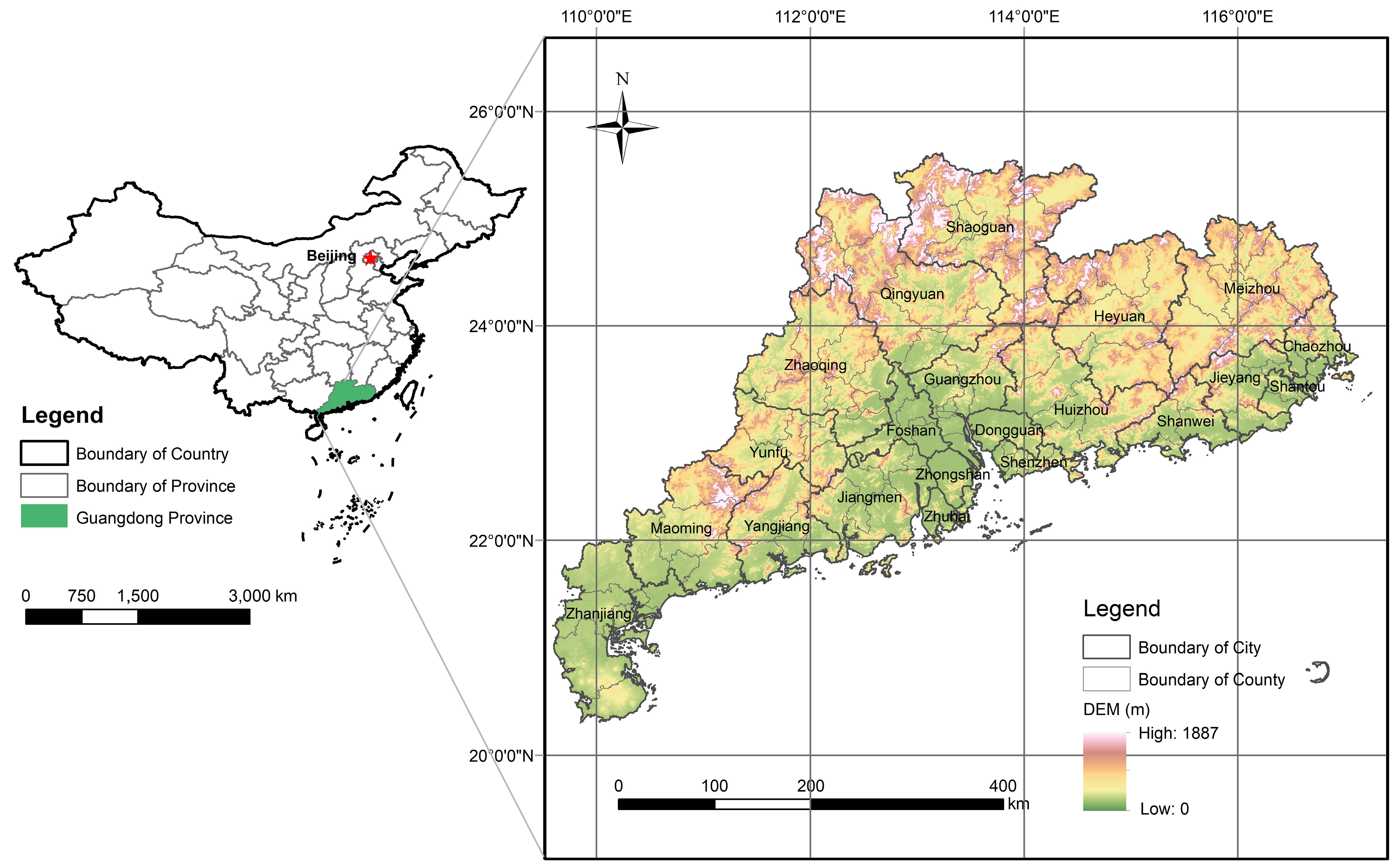

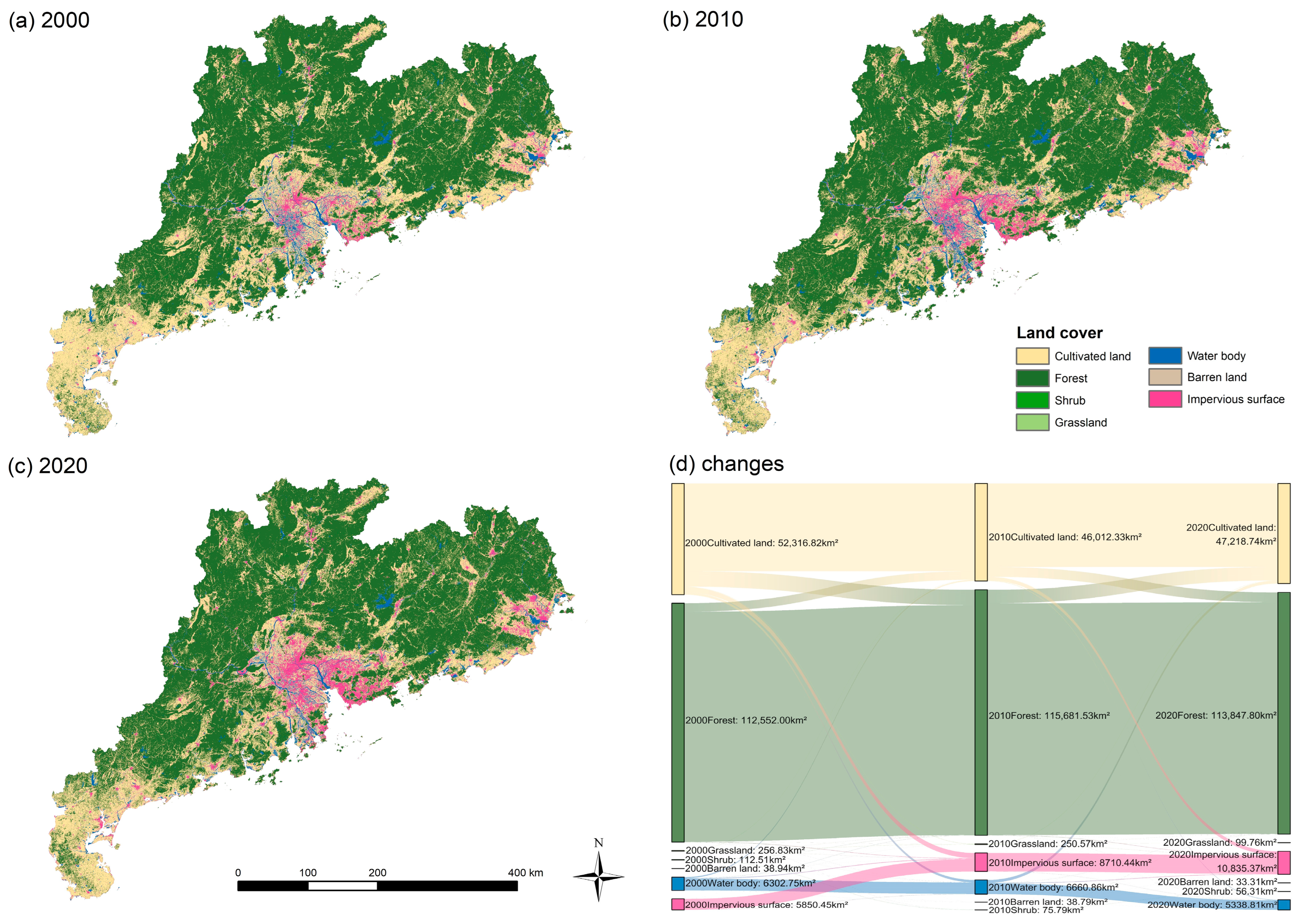
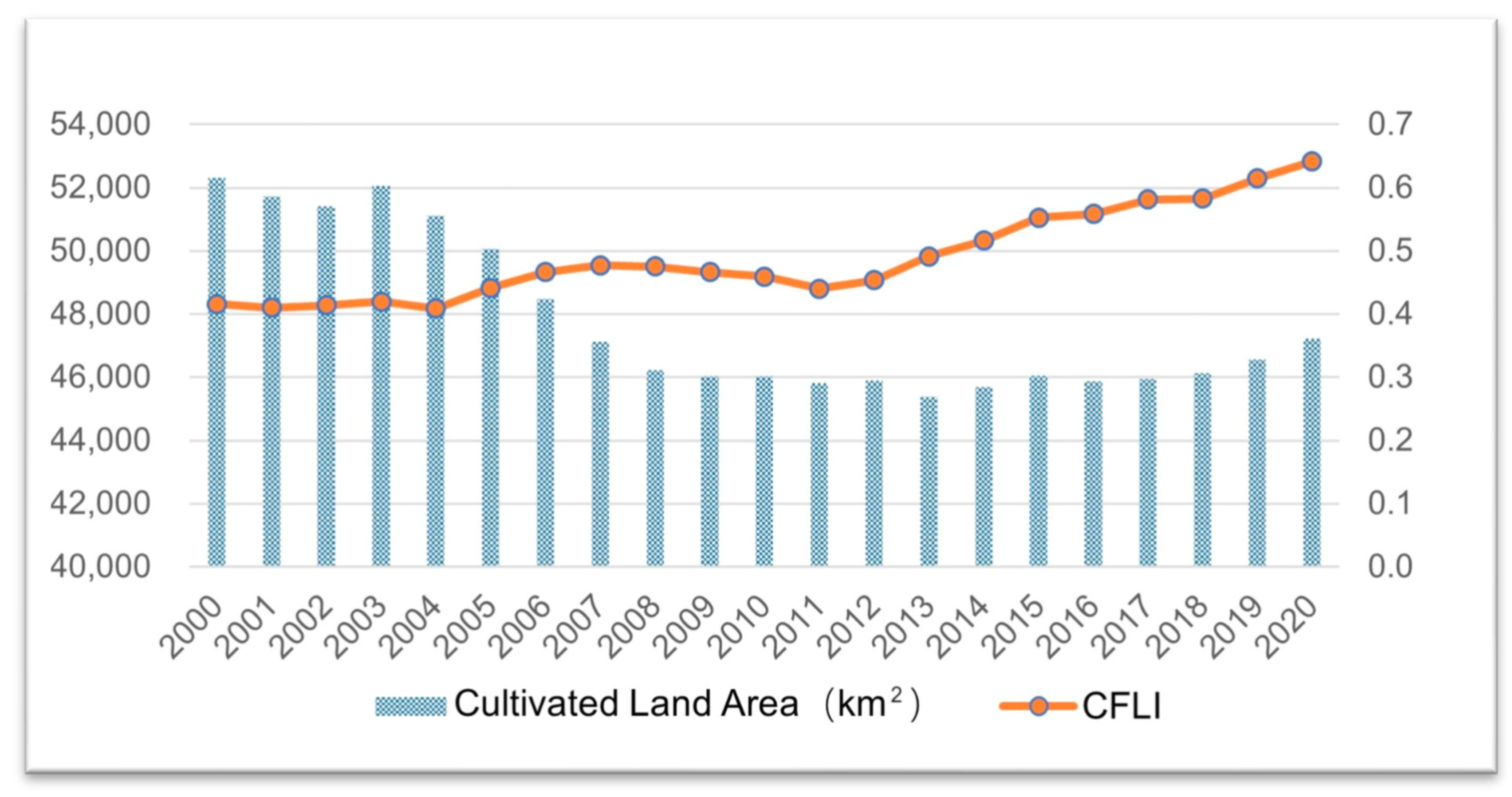
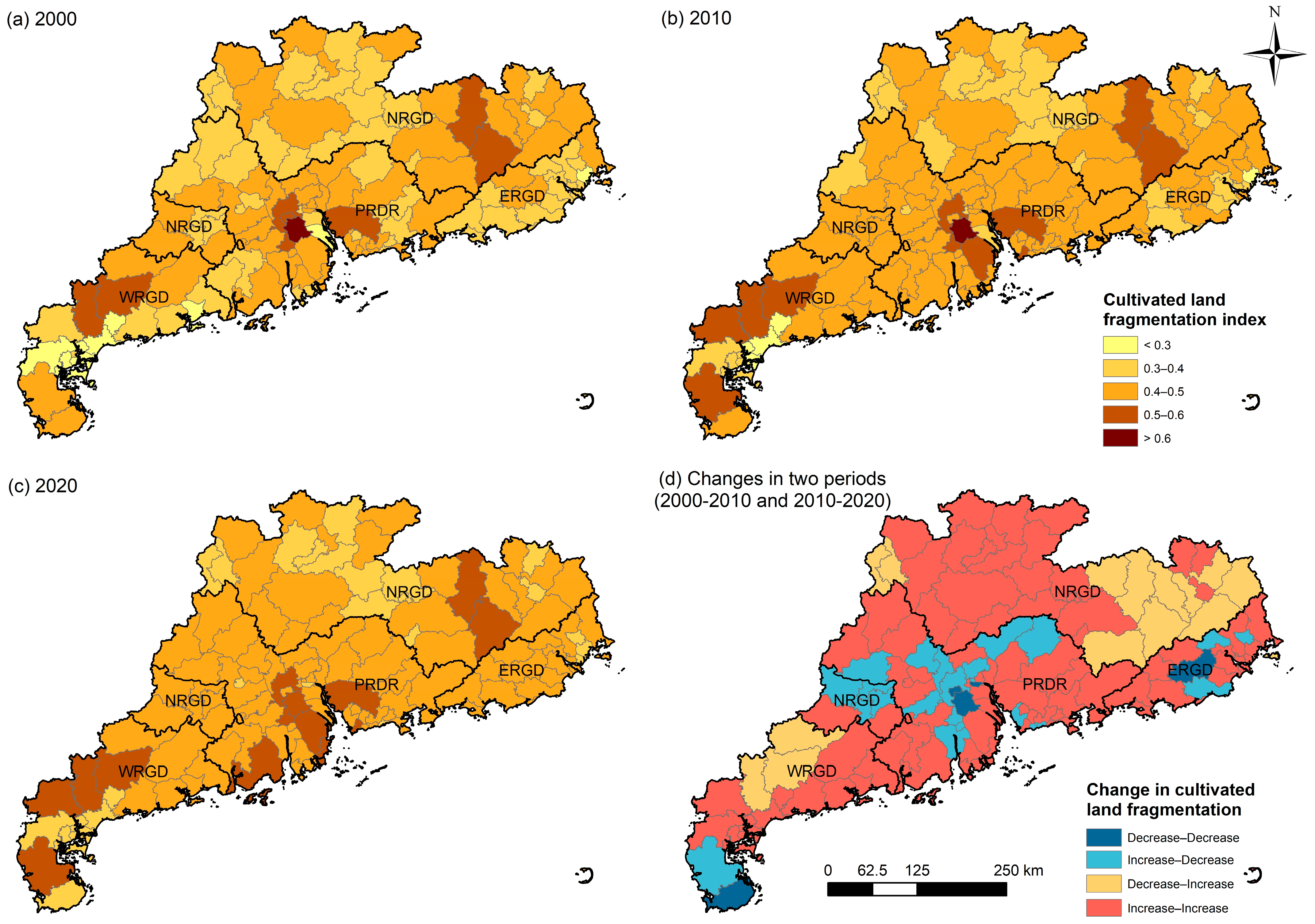
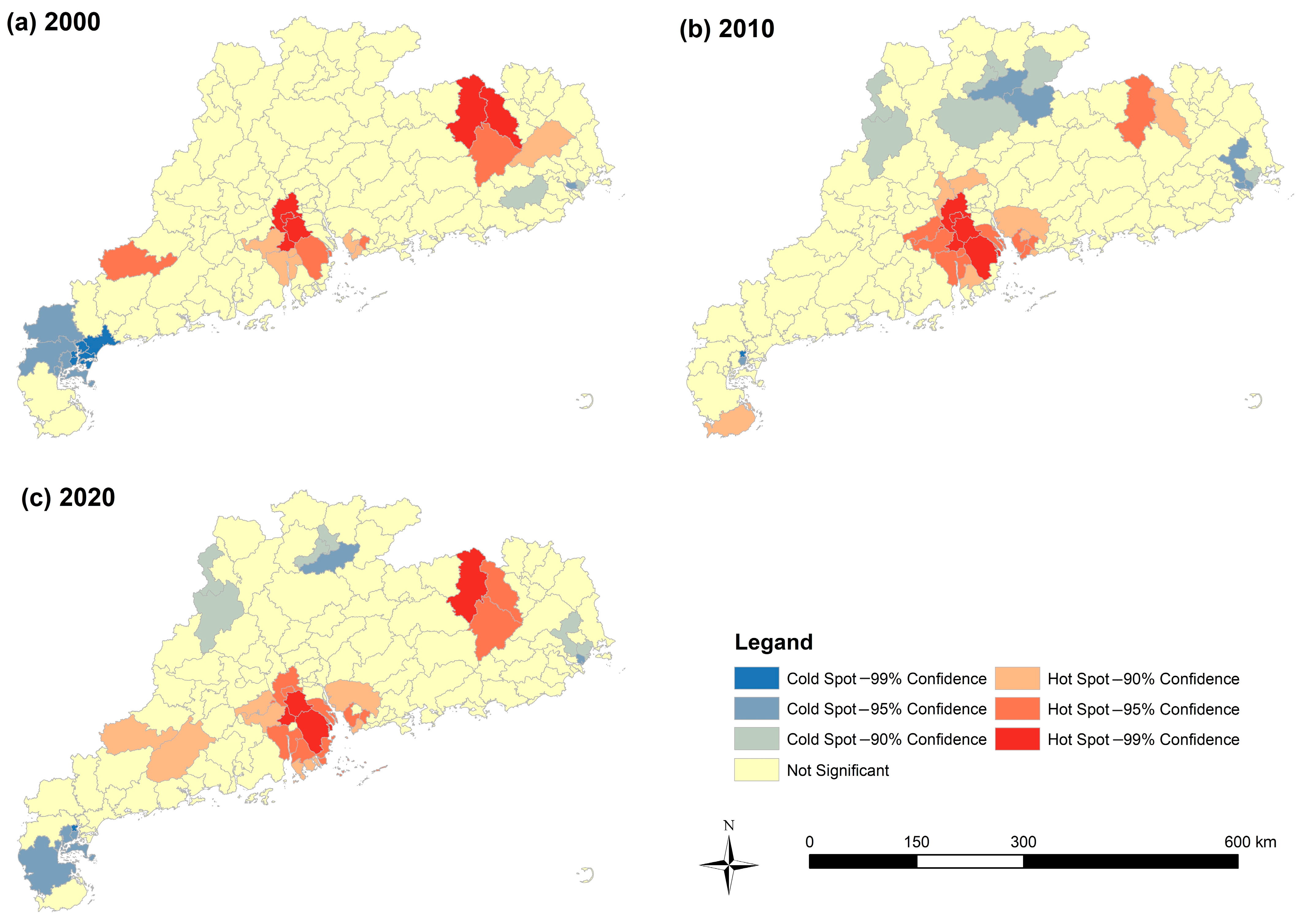
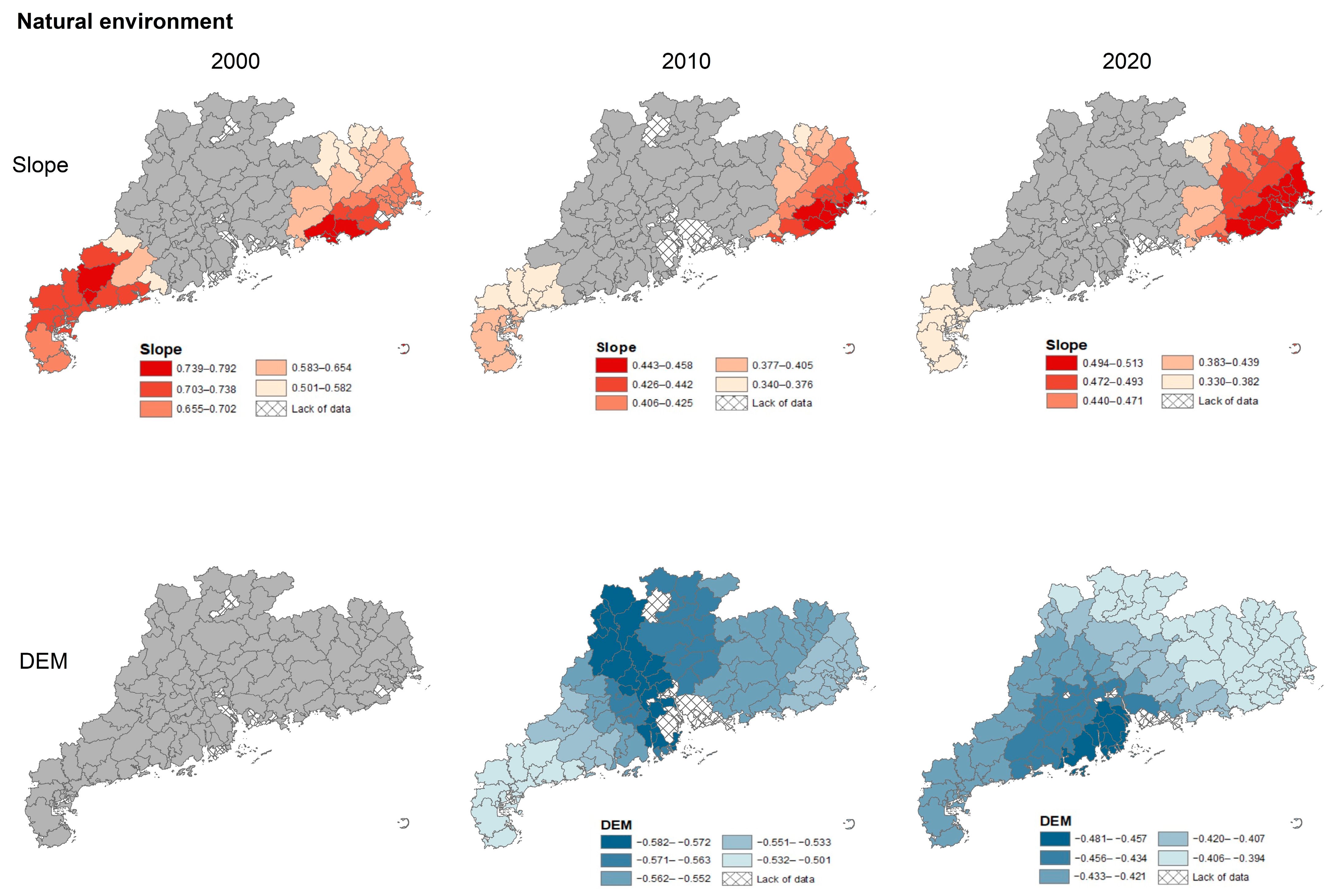


| Data Types | Sources | Resolution | Format | Website |
|---|---|---|---|---|
| Administrative district data | The department of natural resources management | / | Shapefile | / |
| Land cover | China land cover dataset (CLCD), accessed on 21 October 2023. | 30 m | Raster | http://irsip.whu.edu.cn/resources/CLCD.php |
| DEM | ASTER GDEM, accessed on 17 November 2021. | 30 m | Raster | http://www.gscloud.cn |
| Meteorology | Resource and environment science and data center accessed on 5 June 2024 | 1 km | Raster | https://www.resdc.cn |
| Water network and road network | Open Street Map. accessed on 1 March 2023. | / | Shapefile | https://openmaptiles.org |
| Socio-economic data | Statistical Yearbooks for Guangdong Province and Rural Statistics Yearbooks for Guangdong Province accessed on 4 June 2024 | County level | Spreadsheet | https://stats.gd.gov.cn/gdtjnj/ |
| Indicator | Abbreviation | Description | Weight |
|---|---|---|---|
| Percentage of the landscape | PLAND | PLAND equals the percentage of the landscape comprised of the corresponding patch type. | 0.1352 |
| Patch density | PD | PD equals the number of patches of the corresponding patch type divided by the total landscape area. | 0.1067 |
| Edge density | ED | ED equals the sum of the length of all the edge segments involving the corresponding patch type, divided by the total landscape area. | 0.1378 |
| Landscape shape index | LSI | LSI equals the total length of the edge divided by the minimum possible length of the class edge for a maximally aggregated class. | 0.1351 |
| Aggregation index | AI | AI equals the number of like adjacencies involving the corresponding class, divided by the maximum possible number of like adjacencies involving the corresponding class. | 0.0867 |
| Area-weighted mean patch area | AREA_AM | AREA_AM equals the average size of the patches within a landscape, where the average is calculated based on the area of each patch. | 0.0997 |
| Area-weighted mean fractal dimension | FRAC_AM | FRAC_AM refers to an index that quantifies the complexity or irregularity of a landscape or pattern, where the average fractal dimension is calculated based on the area of each fractal element. | 0.1451 |
| Mean Euclidean nearest-neighbor distance | ENN_AM | ENN_AM equals the average distance between each point and its nearest neighbor within a given spatial area. | 0.0638 |
| Landscape division index | DIVISION | DIVISION equals 1 minus the sum of the patch area divided by the total landscape area, the quantity squared, and the sum of all the patches of the corresponding patch type. | 0.0898 |
| Factor | Index | Unit |
|---|---|---|
| Natural environment | DEM | m |
| Slope | ° | |
| Water network density | km/km2 | |
| Average temperature | °C | |
| Annual precipitation | mm | |
| Agricultural benefits | Gross output value of agriculture | 104 RMB |
| Output of grain | t | |
| Average grain output per mu | kg/mu | |
| Per capita disposable income of rural households | RMB | |
| Social economic development | Per capita gross domestic product | RMB |
| Per capita disposable income of urban households | RMB | |
| Local government budgetary expenditure | 104 RMB | |
| Ratio of disposable income per urban household to disposable income per rural household | / | |
| Road network density | km/km2 | |
| Number of agricultural employees | / | |
| Proportion of rural labor engaged in non-agricultural industries | % |
| Year | 2000 | 2010 | 2020 | |||
|---|---|---|---|---|---|---|
| Models | GWR | MGWR | GWR | MGWR | GWR | MGWR |
| AIC | 283.108 | 245.601 | 233.102 | 225.248 | 247.627 | 218.273 |
| AICc | 293.647 | 273.099 | 244.259 | 235.053 | 257.227 | 243.187 |
| R2 | 0.435 | 0.689 | 0.603 | 0.658 | 0.584 | 0.752 |
| Adj.R2 | 0.329 | 0.565 | 0.534 | 0.543 | 0.512 | 0.659 |
| Variable | 2000 | 2010 | 2020 | ||||||
|---|---|---|---|---|---|---|---|---|---|
| Coef. | Band-Width | Coef. | Band-Width | Coef. | Band-Width | ||||
| Mean | STD | Mean | STD | Mean | STD | ||||
| DEM | −0.193 | 0.004 | 107 | −0.555 | 0.018 | 102 | −0.421 | 0.022 | 103 |
| Slope | 0.376 | 0.282 | 48 | 0.258 | 0.135 | 75 | 0.304 | 0.128 | 75 |
| Water network density | −0.043 | 0.028 | 107 | −0.081 | 0.018 | 102 | −0.058 | 0.030 | 103 |
| Average temperature | −0.071 | 0.009 | 107 | −0.118 | 0.024 | 102 | −0.137 | 0.026 | 107 |
| Annual precipitation | 0.066 | 0.021 | 107 | −0.196 | 0.008 | 102 | −0.043 | 0.026 | 103 |
| Gross output value of agriculture | 0.277 | 0.186 | 68 | 0.045 | 0.091 | 98 | 0.194 | 0.088 | 105 |
| Output of grain | −0.601 | 0.407 | 44 | 0.862 | 0.022 | 102 | 0.562 | 0.101 | 80 |
| Average grain output | −0.061 | 0.002 | 107 | −0.038 | 0.041 | 102 | −0.166 | 0.009 | 107 |
| Per capita disposable income of rural households | −0.721 | 0.012 | 107 | 1.634 | 0.165 | 62 | 0.462 | 0.041 | 89 |
| Per capita gross domestic product | −0.059 | 0.008 | 107 | −0.223 | 0.006 | 102 | −0.105 | 0.007 | 107 |
| Per capita disposable income of urban households | 0.459 | 0.007 | 107 | −1.418 | 0.012 | 102 | −0.331 | 0.016 | 107 |
| Local government budgetary expenditure | 0.185 | 0.003 | 107 | 0.551 | 0.006 | 102 | 0.357 | 0.278 | 44 |
| Ratio of disposable income per urban household to disposable income per rural household | −0.376 | 0.113 | 93 | 1.119 | 0.027 | 102 | 0.224 | 0.003 | 107 |
| Road network density | −0.032 | 0.020 | 107 | −0.089 | 0.025 | 101 | 0.046 | 0.092 | 97 |
| Number of agricultural employees | 0.472 | 0.101 | 93 | −0.730 | 0.020 | 102 | −0.224 | 0.074 | 81 |
| Proportion of rural labor engaged in non-agricultural industries | −0.010 | 0.026 | 103 | −0.336 | 0.057 | 90 | 0.112 | 0.250 | 46 |
| Total power of agricultural machinery | 0.014 | 0.005 | 107 | 0.057 | 0.065 | 102 | / | / | / |
Disclaimer/Publisher’s Note: The statements, opinions and data contained in all publications are solely those of the individual author(s) and contributor(s) and not of MDPI and/or the editor(s). MDPI and/or the editor(s) disclaim responsibility for any injury to people or property resulting from any ideas, methods, instructions or products referred to in the content. |
© 2024 by the authors. Licensee MDPI, Basel, Switzerland. This article is an open access article distributed under the terms and conditions of the Creative Commons Attribution (CC BY) license (https://creativecommons.org/licenses/by/4.0/).
Share and Cite
Su, M.; Sun, K.; Deng, B.; Cheng, N.; Cao, Y. Quantification and Driving Factors of Cultivated Land Fragmentation in Rapidly Urbanizing Area: A Case Study in Guangdong Province. Remote Sens. 2024, 16, 2633. https://doi.org/10.3390/rs16142633
Su M, Sun K, Deng B, Cheng N, Cao Y. Quantification and Driving Factors of Cultivated Land Fragmentation in Rapidly Urbanizing Area: A Case Study in Guangdong Province. Remote Sensing. 2024; 16(14):2633. https://doi.org/10.3390/rs16142633
Chicago/Turabian StyleSu, Mengyuan, Kaiying Sun, Boyang Deng, Nuo Cheng, and Yu Cao. 2024. "Quantification and Driving Factors of Cultivated Land Fragmentation in Rapidly Urbanizing Area: A Case Study in Guangdong Province" Remote Sensing 16, no. 14: 2633. https://doi.org/10.3390/rs16142633





